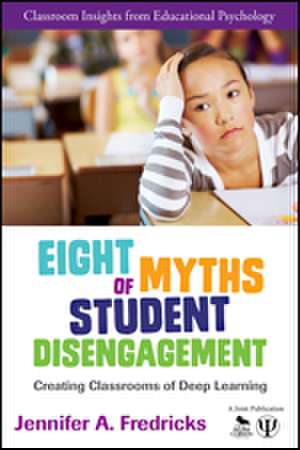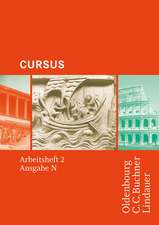Eight Myths of Student Disengagement: Creating Classrooms of Deep Learning: Classroom Insights from Educational Psychology
Autor Jennifer Ann Fredricksen Limba Engleză Paperback – 30 apr 2014
Preț: 244.14 lei
Nou
Puncte Express: 366
Preț estimativ în valută:
46.72€ • 48.100$ • 38.89£
46.72€ • 48.100$ • 38.89£
Carte tipărită la comandă
Livrare economică 01-15 aprilie
Preluare comenzi: 021 569.72.76
Specificații
ISBN-13: 9781452271880
ISBN-10: 1452271887
Pagini: 272
Dimensiuni: 152 x 229 x 20 mm
Greutate: 0.44 kg
Ediția:New.
Editura: SAGE Publications
Colecția Corwin
Seria Classroom Insights from Educational Psychology
Locul publicării:Thousand Oaks, United States
ISBN-10: 1452271887
Pagini: 272
Dimensiuni: 152 x 229 x 20 mm
Greutate: 0.44 kg
Ediția:New.
Editura: SAGE Publications
Colecția Corwin
Seria Classroom Insights from Educational Psychology
Locul publicării:Thousand Oaks, United States
Recenzii
"A must have book for all classroom teachers. A relevant, eye-opening approach to classroom problems and student attitudes that we didn’t think we could solve."
"This was an excellent read that would be very applicable in most classrooms. Engagement is key to student learning and the author gives us practical ways to implement real practices aimed at increasing this engagement of students at all learning levels."
"In the era of Common Core Standards, this book is a must read for every educational professional!"
"This was an excellent read that would be very applicable in most classrooms. Engagement is key to student learning and the author gives us practical ways to implement real practices aimed at increasing this engagement of students at all learning levels."
"In the era of Common Core Standards, this book is a must read for every educational professional!"
Cuprins
Preface
Acknowledgments
About the Author
About the Contributors
Introduction
Myth 1. It's Easy to Tell Who Who Is Engaged: What Is Engagement and How Can I Assess It in My Classroom?
Portraits of Engagement
What Is Engagement?
Why Assess Engagement?
Consistency, Duration, and Variation in Engagement
Methods for Assessing Engagement
Chapter Summary
Text-to-Practice Exercises
Key Terms and Concepts
Research-Based Resources
Myth 2. Some Students Just Don't Care: How Disengagement Is More Than Just a Lack of Student Motivation
School Versus Out-of-School Tasks
Teacher-Student Relations and Disengagement
Peer Relations and Disengagement
Chapter Summary
Text-to-Practice Exercises
Key Terms and Concepts
Research-Based Resources
Myth 3. What Happens Outside of School Competes With Academics: How Out-of-School Time and Families Affect Engagement in School
Extracurricular Activity Participation and Academic Outcomes
Variation in Engagement Across Contexts
Self-Determination Theory and Engagement
Families and Engagement
Barriers to Parent Involvement
Chapter Summary
Text-to-Practice Exercises
Key Terms and Concepts
Research-Based Resources
Myth 4. Hands-On Is Minds-On: How to Create More Engaging Classroom Tasks That Result in Deep Learning
Designing Classroom Tasks for Engagement
Cognitive Components of the Task
Authentic Tasks
Authentic Instructional Models
Motivational and Cognitive Challenges With Authentic Instruction
Strategies for Implementing Cognitively Complex Tasks
Chapter Summary
Text-to-Practice Examples
Key Terms and Concepts
Research-Based Resources
Myth 5. Focus on Content: Don’t Make It Personal: How Relationships Matter for Student Engagement
Teacher Support and Student Engagement and Achievement
Essential Characteristics of Meaningful Teacher-Student Relations
Building Relatedness in the Classroom
Being an Autonomy-Supportive Teacher
Supporting Students' Need for Competence
How Teachers Support Cognitive Engagement
Barriers to Developing High-Quality Relationships
Building Relationships With Difficult Students
Connecting With Diverse Students
Chapter Summary
Text-to-Practice Exercises
Key Terms and Concepts
Research-Based Resources
Myth 6. Socializing With Peers Detracts From Student Engagement: How to Create a Peer Context That Supports Engagement
Why Are Peer Relationships Important?
Friendships
Teachers' Beliefs and Instructional Practices
How Do Peers Socialize Engagement?
Cooperative Learning and Collaborative Instruction
Key Strategies for Supporting Cooperation and Collaboration
Creating Classroom Communities
Chapter Summary
Text-to-Practice Exercises
Key Terms and Concepts
Research-Based Resources
Myth 7. There’s Only So Much a Teacher Can Do: How to Help Those Students Still Struggling to Succeed
Why Is It Important to Resist Disengagement?
Risk Factors for Disengagement
Why Is a Student Disengaged?
Boys and Disengagement
Academic Problems and Disengagement
Students With a History of Behavioral Problems
African American, Hispanic, and Low-Income Students and Disengagement
Interventions to Increase Engagement
Chapter Summary
Text-to-Practice Exercises
Key Terms and Concepts
Research-Based Resources
Myth 8. Student Engagement Is a Student Choice: Choosing to Make the Effort and Not Waiting for Engagement to Happen
References
Index
Acknowledgments
About the Author
About the Contributors
Introduction
Myth 1. It's Easy to Tell Who Who Is Engaged: What Is Engagement and How Can I Assess It in My Classroom?
Portraits of Engagement
What Is Engagement?
Why Assess Engagement?
Consistency, Duration, and Variation in Engagement
Methods for Assessing Engagement
Chapter Summary
Text-to-Practice Exercises
Key Terms and Concepts
Research-Based Resources
Myth 2. Some Students Just Don't Care: How Disengagement Is More Than Just a Lack of Student Motivation
School Versus Out-of-School Tasks
Teacher-Student Relations and Disengagement
Peer Relations and Disengagement
Chapter Summary
Text-to-Practice Exercises
Key Terms and Concepts
Research-Based Resources
Myth 3. What Happens Outside of School Competes With Academics: How Out-of-School Time and Families Affect Engagement in School
Extracurricular Activity Participation and Academic Outcomes
Variation in Engagement Across Contexts
Self-Determination Theory and Engagement
Families and Engagement
Barriers to Parent Involvement
Chapter Summary
Text-to-Practice Exercises
Key Terms and Concepts
Research-Based Resources
Myth 4. Hands-On Is Minds-On: How to Create More Engaging Classroom Tasks That Result in Deep Learning
Designing Classroom Tasks for Engagement
Cognitive Components of the Task
Authentic Tasks
Authentic Instructional Models
Motivational and Cognitive Challenges With Authentic Instruction
Strategies for Implementing Cognitively Complex Tasks
Chapter Summary
Text-to-Practice Examples
Key Terms and Concepts
Research-Based Resources
Myth 5. Focus on Content: Don’t Make It Personal: How Relationships Matter for Student Engagement
Teacher Support and Student Engagement and Achievement
Essential Characteristics of Meaningful Teacher-Student Relations
Building Relatedness in the Classroom
Being an Autonomy-Supportive Teacher
Supporting Students' Need for Competence
How Teachers Support Cognitive Engagement
Barriers to Developing High-Quality Relationships
Building Relationships With Difficult Students
Connecting With Diverse Students
Chapter Summary
Text-to-Practice Exercises
Key Terms and Concepts
Research-Based Resources
Myth 6. Socializing With Peers Detracts From Student Engagement: How to Create a Peer Context That Supports Engagement
Why Are Peer Relationships Important?
Friendships
Teachers' Beliefs and Instructional Practices
How Do Peers Socialize Engagement?
Cooperative Learning and Collaborative Instruction
Key Strategies for Supporting Cooperation and Collaboration
Creating Classroom Communities
Chapter Summary
Text-to-Practice Exercises
Key Terms and Concepts
Research-Based Resources
Myth 7. There’s Only So Much a Teacher Can Do: How to Help Those Students Still Struggling to Succeed
Why Is It Important to Resist Disengagement?
Risk Factors for Disengagement
Why Is a Student Disengaged?
Boys and Disengagement
Academic Problems and Disengagement
Students With a History of Behavioral Problems
African American, Hispanic, and Low-Income Students and Disengagement
Interventions to Increase Engagement
Chapter Summary
Text-to-Practice Exercises
Key Terms and Concepts
Research-Based Resources
Myth 8. Student Engagement Is a Student Choice: Choosing to Make the Effort and Not Waiting for Engagement to Happen
References
Index
Notă biografică
Descriere
Straightforward how-to’s from practicing classroom teachers, print and web-based resources, and assessment tips help educators cultivate lasting student engagement and transform educational outcomes with this must-have resource!











